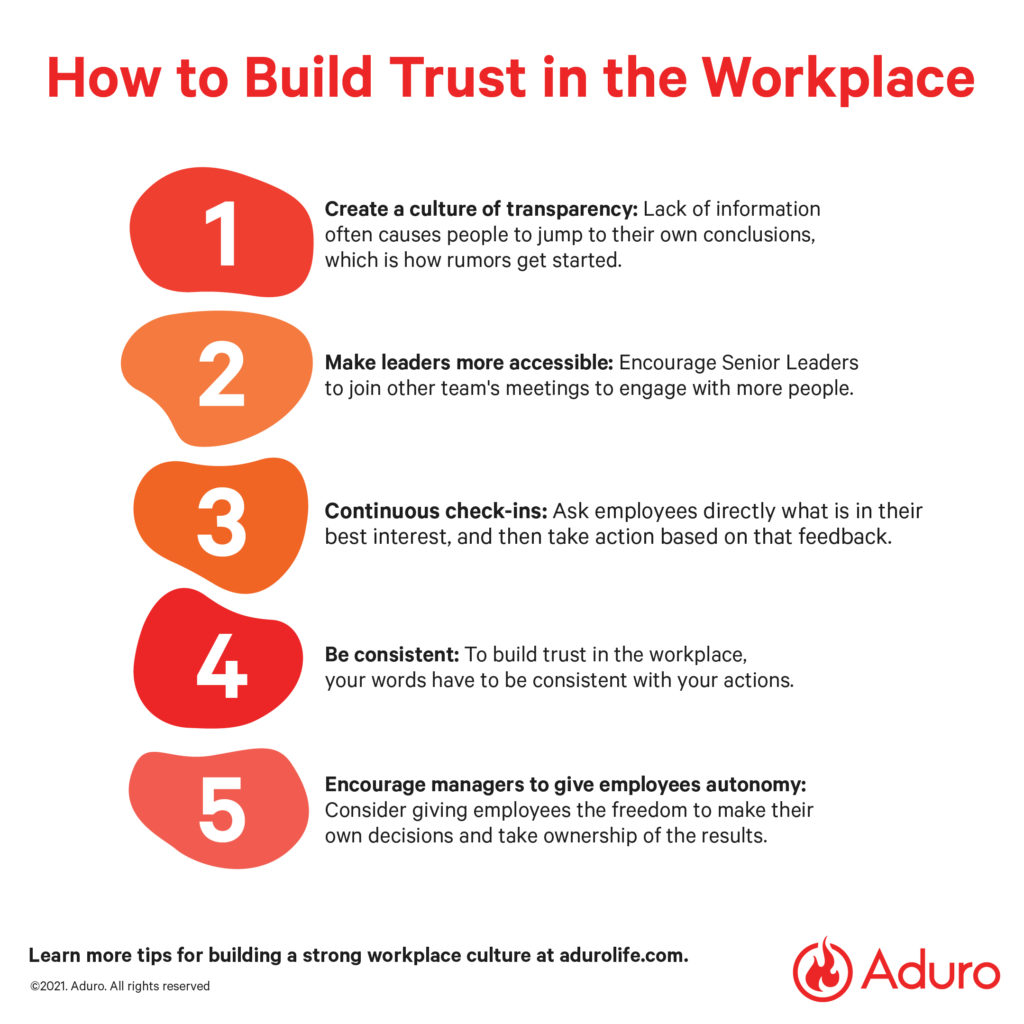Employee Trust is Directly Related to Work Performance
Nearly 75 percent of respondents said they trust their employer, according to the 2019 Edelman Trust Barometer. That pushed employers to the top spot as the most trusted institution, beating out government and media, among others. It makes sense, considering the employer relationship is the one that people have the most control over — they get to choose where they work and they can leave at any time if they’re unhappy.
Employee trust isn’t just tied to retention, however. It’s also key to performance. To perform at our highest potential, we have to have trust in the company we work for and the people leading it. How do we build trust in the workplace? These strategies can help you get there.

1. Create a culture of transparency
Employers may feel they need to shield employees from company problems. However, lack of information often causes people to jump to their own conclusions, which is how rumors get started. Consider sharing information such as performance metrics and notes from board meetings, Harvard Business Review suggests, which can keep employees informed about the company’s standing and build trust with them at the same time.
2. Make leaders more accessible
How well does your CEO know your employees who aren’t on the leadership team? Oftentimes, executives only work with senior leaders and may neglect to really pay attention to employees in non-managerial roles. To help forge bonds with other employees, your CEO might attend different team meetings on occasion, just to listen in and hear directly from different people. You could also increase opportunities for executives to engage with employees in non-formal settings, such as a bowling team-building activity or a corporate 5k. Afterward, you might invite the group to gather together for lunch. When executives let their guard down, it makes employees feel comfortable being their authentic selves, too. Learn tips to shape your leaders for a workplace focused on Human Performance.
3. Continuous check-ins
One of the best ways to build trust in the workplace is to show employees you have their best interest at heart. How do you know what’s in their best interest? Ask them directly — and then take action based on that feedback. To stay ahead of employee needs, Aduro uses a tool called TINYpulse. For example, feedback from TINYpulse showed us that our team wanted a 401(k) plan. It was something we were considering at the time, but we weren’t sure how employees felt about it. TINYpulse made it really clear that they wanted a 401(k) program. We acted upon that feedback and — just one week after rolling out the change — our 401(k) provider let us know that our company opt-in rate was at more than 95 percent, compared to the average 20 percent for other companies. Today, 100 percent of our employees now participate in the 401(k) program. We would never have known how much it mattered to them if we didn’t ask.
4. Be consistent
To build trust in the workplace, your words have to be consistent with your actions. If the two don’t align, it’s a surefire way to lose employee trust. It’s equally important to ensure that your message doesn’t change based on the audience. For example, if you’re communicating difficult news to upper management and then to employees, be honest and forthright with both groups vs. sugar-coating it. That honesty will really go a long way. Along those same lines, treat everyone equally. Leaders may naturally have strong relationships with certain employees, but it’s critical to never play favorites and give special privileges to some employees that aren’t available to others. Everyone deserves equal treatment — and their trust in the company hinges on it. Learn ways to build an authentic culture in your organization.
5. Encourage managers to give employees autonomy
Traditionally, a manager was viewed as a “boss” — someone who had authority over an employee and told them what to do and how to do it. Thankfully, that idea has become antiquated at many organizations. Over time, companies have realized that telling people what to do doesn’t bring out the best in them. In fact, it stifles it. Instead, consider giving employees the freedom to make their own decisions and take ownership of the results. For example, you might have managers who perform internal quality checks of all of their employees’ work before it goes out the door to clients. Ask them if they still feel like this extra step is necessary, especially for employees who have continuously delivered high-quality work. If not, encourage them to speak to employees to let them know that — from here on out — they will be the last set of eyes on their deliverables. You trust them to finalize the project and make sure it’s client-ready. Trust is a two-way street. When managers show employees they’ve earned their trust, it’s often reciprocated. Learn about the role managers can play in supporting employee wellness.

